By Mwallau
The Florida Panhandle has been suffering through a drought that has reduced early season hay production. With summer halfway over, it is important to have a good strategy through the remainder of the growing season to ensure you have enough hay or baleage for the coming winter. There are a few options that producers can explore:
First, there is still time to put up good quality hay. As moisture conditions improve and grasses start growing very fast, fertilizing with 50 – 80 lb N/A and the recommended amount of P and K (based on soil test) can significantly improve forage production (
When is the Best Time to Fertilize Your Perennial Pastures?). As we move later into summer, remember there is a fertilization threshold for summer pastures around mid-August, after which fertilization will no longer be profitable. As the days shorten our perennial grasses respond less to fertilization. The threshold varies depending on species and cultivar. For example, as compared to Pensacola, Riata bahiagrass is less sensitive to reduction in day length and continues growing longer in the fall, pushing the threshold somewhat later. However, all grasses will have an increasingly reduced response to fertilization through the end of the growing season, as plants prepare for dormancy. Consult with your local
extension agent to determine the best fertilization strategy for your operation.
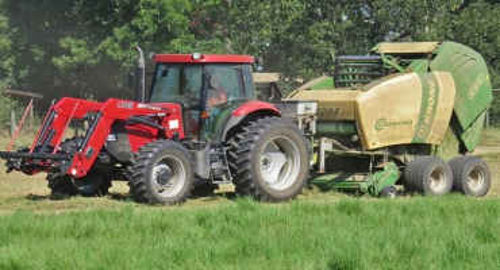
There is still time to produce good quality hay this summer. As moisture conditions improve and grasses start growing very fast, fertilization can significantly improve forage production.
Another option to consider, after fertilization, is to set aside select paddocks for deferred grazing or additional hay acreage. Researchers at the University of Florida and Auburn have been evaluating the practice of stockpiling forages for several years (
Stockpiled Grazing Can Reduce Winter Feeding Costs). Bahiagrass is not a good choice for stockpiling, because the digestibility declines so much when mature. However, Bermudagrass or limpograss are much better options since they produce a high quantity of forage afer fertilization and are more digestible when they are mature.
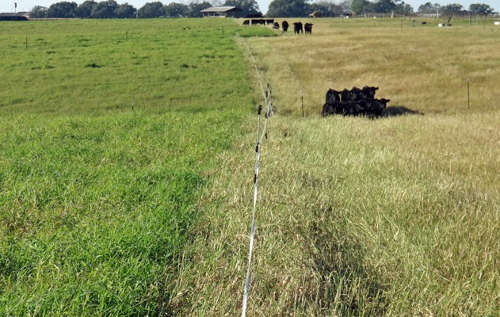
Researchers at Auburn University have conducted research trials feeding cow-calf pairs and stocker calves on stockpiled Tifton 85 bermudagrass at the Wiregrass Research and Education Center in Headland, Alabama. This photo was taken on December 9, 2015 before the temporary electric fenced was moved over to allow access to fresh grazing. Notice that the heifers are mainly grazing on the tender, high quality leaves and leaving the course stems that are much higher in fiber.
Third, consider establishing winter pastures. Establishment costs for implementing winter pastures range from $100 to $300 per acre, depending on planting method and fertilization, and there is always production uncertainty without irrigation. In most years the risk is worth the gamble, because productive cool-season annual forages can significantly reduce feeding costs and provide improved animal performance. Those pastures can produce up to 5 tons of dry matter per acre, with crude protein ranging from 12 to 18%, and TDN from 60 to 80%. Stockers and replacement heifers can convert over 2 lb of average daily gain from cool-season annual pastures! Even a planting cool-season forages as late as early-December can still pay off, if you can get at least 100 days of grazing out of them. Consult with your local
extension agent to determine the best variety options for your area (
Cool-Season Forage Variety Recommendations).
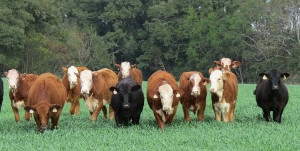
Replacement heifers gain more than 2 lbs./day on cool-season forages at the North Florida Research and Education Center (NFREC), Marianna – FL.
Last, if none of those choices are possible, ensure you have an adequate supply of hay by purchasing early enough to ensure decent quality hay is available. With potentially higher than normal demand, a shortage could drive prices up as winter approaches. Lining up hay to purchase early can save you money and reduce the headache of searching for a new supplier.
Some important considerations for hay purchasing, storage and feeding:
Figure 1. Feeding hay directly on the ground, without a ring or feeder, can result in feeding waste exceeding 45%. Credit: Marcelo Wallau.
The amount of hay needed – either produced or purchased – will depend on herd size, intake, and storage and feeding waste. You can estimate between 1.5 and 2% of the animal’s weight in dry matter intake from hay each day, but don’t forget to factor in 5% to 30% waste, depending on feeding and storage methods. This means that for each 1100-lb cow, you will need 16 to 22 lb of dry matter of hay each day (19 to 25 lb “as fed”@ 13% moisture) plus the waste (Table 1). Storing hay in a barn reduces storage waste to as little as 2-5%, while storing hay outside, even on well drained ground, can
result in 15 – 40% losses! Feeding waste can be very significant as well. While using a hay ring can minimize loses, feeding straight on the ground (Figure 1) can result in
over 45% waste. All those factors have to be considered when planning how much hay to produce or purchase.
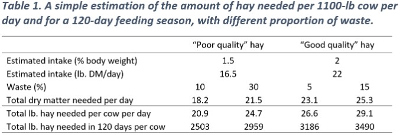
Because of depressed intake, less low-quality hay is required for the winter, but will also require a greater amount supplemental feed to meet requirements. Table 2 shows a simple comparison of feeding a 1100-lb cow in mid- to late-gestation with three types of hay supplemented with dried distiller’s grains (DDG) at an approximate cost of $200/ton. Low quality hay (low protein and digestibility) will result in reduced intake, greater need for supplementation and increased waste. While our “good quality hay” supplies all crude protein and total digestible nutrient demands for this simulated cow, the “bad quality hay” – our famous “cow hay” – will require supplementation costing extra $0.16 per animal per day (not considering the cost of labor). That’s why cheap hay may end up costing a lot more in the end. (How Much Does Bad Hay Cost a Beef Cattle Producer?)
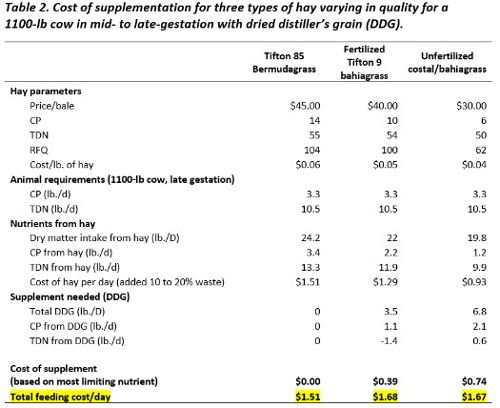
The worst case scenario is to buy the cheaper, low-quality hay and then cut corners on supplementation as well. It is very tempting in periods with lower cattle prices to cut back on winter feeding. I am sure you have heard the age old saying, “You can’t starve a profit out of a cow!” There is a great deal of truth to this phrase. Cattle can get really thin in a hurry in the winter after calving, if they are not getting enough energy from their diet. The first thing that goes is reproduction, as the cow wont cycle if energy is deficient. If they keep getting thinner, their immune systems become depressed, and that is when the train-wreck of sickness and even death loss begins.
The main point is to start preparing now, so you don’t get caught in a bad situation. There is still time to boost both the yield and quality of your hay-fields with fertilization. There are other options that can be used to extend the grazing season. If you need to purchase hay, you may want to start shopping around earlier this year, to make sure you can get the quantity and quality you need. And finally, there are ways to reduce both storage and feeding waste, to make the most of your inventory.